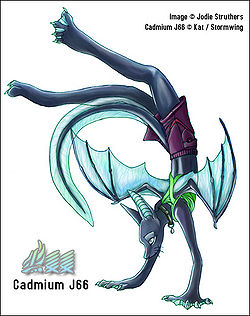Aquabat
| Aquabat ak-wah bat | |
|---|---|
| Plural: | Aquabats |
| Scientific Name: | resaquatilis sapiens |
| Homeworld: | Ramath-lehi |
| Characteristics | |
| Height: | 1.65 m (5 ft 5 in) - 2 m (6 ft 7 in) |
| Weight: | 38.56 kg (85 lbs) - 72.57 kg (160 lbs) |
| Colouration: | Generally are seen in varying hues of green, blue and violet to blend in with the ocean depths. |
| Creation Notes | |
| All Aquabats have a pack identification tattoo inscribed on their right palm. | |
Description
Aquabats are amphibious, and spend a majority of their life in oceans, seas, inlets, and even large freshwater lakes. This lifestyle and habitat difference has bred various physiological traits that are unique to the Aquabat. They have finer features, with fox-like faces and sensitive facial whiskers for seeking prey in murky waters. Their entire body is streamlined for quick swimming, and they have webbed hands and feet, as well as a rudder-like tail. Some even have fins that extend off the tail, which, combined with shoulder or underarm wingspans, aid in underwater movement. Aquabats also have slim air bladders beneath their skin, which help them float, or sink, depending on to what degree they are inflated. They also have the ability to breathe through their skin, an innovation that enables them to venture safely on either land or water. Echolocation is another strength they have developed in order to excel in their aquatic environment. Aquabats have a large range of sounds, mostly clicks, that they use to locate prey. Lastly, their breeding habits differ from Pendragons and other species. Females carry the eggs in a pouch instead of leaving them in a nest, where they could be eaten, or otherwise wash away. Also, in a single-sex environment, Aquabats can change sex, in order to increase breeding output.
Reproduction and Social Life
Socially, Aquabats are also unique. Almost all of them live in packs, although the degree of civilization from pack to pack varies greatly. Some packs live in cities, like Aurius, but others live in open oceans and seas, hunting like primitive carnivores. Some very bold individuals venture away from the water, and their families, to embark in a life on dry land. This is an uncommon practice however, because Aquabat packs are tightly knit. They usually consist of a grandmother, the matriarch, along with her offspring and her offspring's offspring.
Within the pack, there is a hierarchy. The grandmother, or else the eldest female, is the equivalent of an Alpha female. She often has an immediate subordinate or two, or her Betas. Their gender doesn't matter. Beyond that, she might have such things as Sentinels, Guardians, and Nioti-sitters. Every Aquabat has a place in the pack.
In order to display these position and level of dominance within their pack, Aquabats are known to breach. They can breach several feet into the air, even at a dead start. They are very flashy when they do so, whipping tails, spreading wings, and so forth. Some even glide for a bit on their wings, before re-entering the water.
Besides having positions and ranks within the pack, each member also has a number. Most Aquabats don't have a surname; in its place, they have the alphabetical letter of their pack — for example, J for the JPack — as well as the number given to them at birth. This number is assigned by their chronological time of arrival in the pack, but only if they are born into it. Those that have transferred from other packs are stuck with their original letter and number, as well as with an unbreakable connection to their birth pack, though they are almost always embraced by their newer pack. At birth, each Aquabat is tattooed with their Ramathian letter and numeral, so that they will be eternally marked, and carry the emblem of their pack's pride. All Aquabats' pack identification tattoos are inscribed on their right palm. In way of example, Cadmium J66's tattoo looks like this:
Hunting is a major part of pack life. Whether they hunt primitively or use modern means to aid their quest for food, all Aquabats are formidable carnivores. They have several hunting techniques. The most common is for a pack to simply give chase, each individual using hands and teeth in order to kill the prey, which is often fish or small aquatic mammals. A more advanced technique, which must be employed with the cooperation of the pack, is to herd the prey, and then stun it by slapping or lashing with the tail. Sometimes while doing this, Aquabats also toss the prey around, until it is essentially "played" to death. The most modern Aquabat packs use nets and other contemporary tools in order to catch large harvests of prey, and they store their catches for later consumption.
To prevent inbreeding, Aquabats seek mates outside of the pack. Young Aquabats will leave their birth pack to join a mate in theirs, but the more common scenario is for two young Aquabats to meet, mate, and then move on, with the female of the encounter raising the young. A few Aquabats are monogamous, and more likely to switch packs, while most are polyamorous.
Aquabat Packs
Habitat
Oceans, seas, inlets, and large freshwater lakes.
History
They share an ancient bloodline with Pendragons, but have branched off far enough over the millennium to be considered a separate, evolved species.
| |||||||||||

